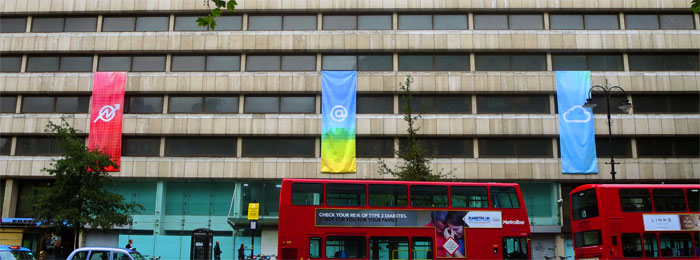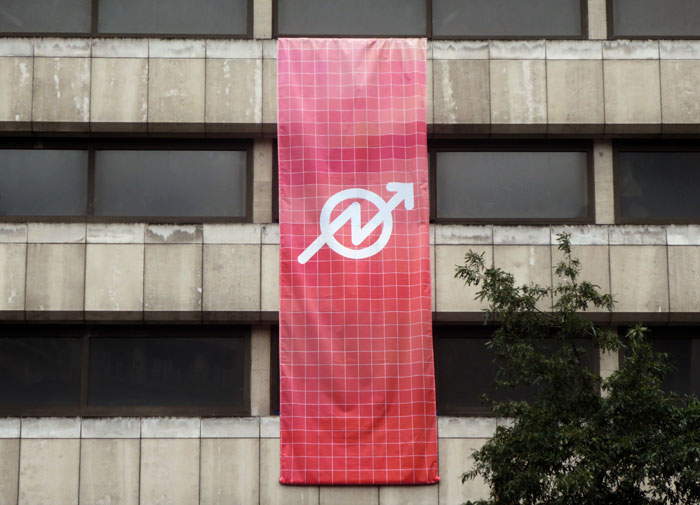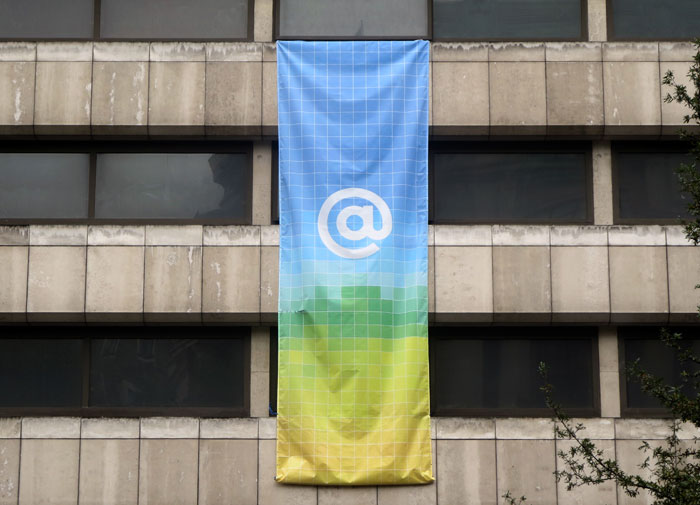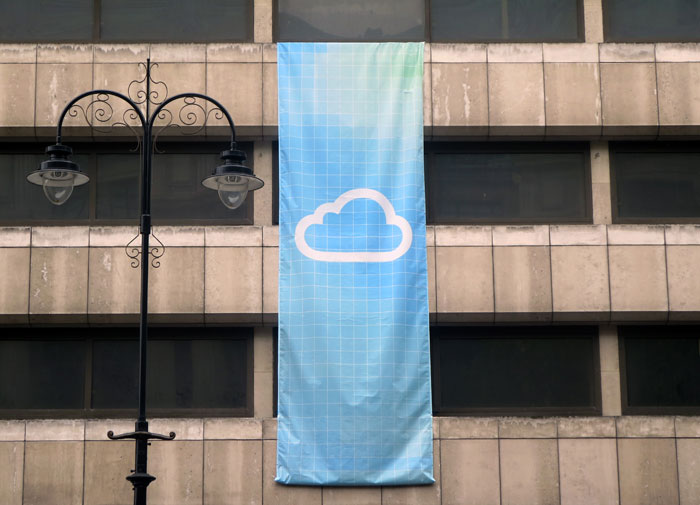“Occupy the Cloud”, an installation for Open Heart Surgery, The Moving Museum, 180 Strand, October – December 2013.

“Occupy the Cloud” is an installation of three banners on the facade of 180 Strand, a brutalist office block on a main road in central London. The banners are made of pixelated, virtual skies taken from architectural renderings, like those which adorn nearby building sites. They feature three symbols: the lightning bolt through a circle of the international squatters’ movement; the @-symbol used to denote digital location or direction (and acquired in 2010 by MoMA); and the Cloud symbol, which has come to stand for the vast and remote data storage and processing capabilities of corporations and governments. (I have previously made the assertion, both humorously and more directly that the Cloud is a lie.) The banners themselves occupy an uneasy position between corporate branding, and protest.
When I was asked to contribute to the Moving Museum’s London show, I initially intended to make work based on my ongoing Render Ghosts project, which examines the effects of software designs and processes on society and the built environment (I’ve previously written about this for Domus). One plan was to create flags for the Render Ghosts, who are the people who appear in architectural visualisations, to mark their occupation of that liminal space between the real and the virtual, the physical and the digital, the present and the future.
A couple of things focussed the work. The first was a site visit to 180 Strand, a vast and currently empty building in central London, surrounded by major streets, and major developments (the next site on the street, surrounded by hoardings, boasts “a luxurious new development of stunning apartments and penthouses”). The second was my experience of censorship in Australia last month. I realised it would be possible to make a very public work; and there was no point in being subtle.

In the last few months we’ve learned much about the extent to which supposedly secure “cloud” services have been infiltrated by our security services without oversight or consent. The latest revelations detail explicitly how data passed between Google and Yahoo servers is directly intercepted. But anyone who saw the hundreds of metal barriers which were used to fill Paternoster Square by its corporate owners in February 2012 to prevent peaceful protestors approaching the London Stock Exchange is unlikely to assume that we can trust corporations to act in our best interests any more than governments. Indeed, some of them are starting to act like governments, and no less opaquely than the traditional nation-states.
At the same time, the UK government’s primary response to rising house prices and rental costs, a lack of affordable housing, local councils moving residents out of the city, and a steep rise in homelessness, has been to criminalise squatting, a practice which has a long and radical tradition in this country.
The Levellers and the Diggers of the 17th Century occupied public lands and cultivated them for the public benefit – the state and the landowners conspired to imprison and execute them. It was a young Leveller, John Lilburne, whose false imprisonment and torture lead directly to the establishment of the principle of human rights in English law, and the founding documents which became the US Constitution and Bill of Rights. It is those same rights and laws which have been so violently abused over the last decade to permit exactly the same tortures and renditions which Lilburne was subjected to. The brutal reactions to peaceful public protest in the UK, from Occupy to anti-war marches and the student protests, reveal the illusion of “public” space once again.
As I write this, the UK government is debating its own oversight of the intelligence and security services. The MP Tom Watson, as well as linking the abuse of secrecy powers to the CIA’s drone assassination programme, just made the assertion that “An individual’s data is like their vote: individually minor, privately performed, and hugely powerful when aggregated. We should no more tamper with an individual’s data than tamper with their vote.” In my essay earlier this Summer for Matter magazine, Ring of Steel, I attempted to show how our technological systems tend towards secrecy, and are complicit in abuses of state power, and blanket, undemocratic surveillance. In his essay Turnkey Tyranny, Surveillance and the Terror State, Trevor Paglen states that “[b]y exposing NSA programs like PRISM and Boundless Informant, Edward Snowden has revealed that we are not moving toward a surveillance state: we live in the heart of one.” Paglen asserts that networked technologies as they are employed now do “not merely provide the capacity for “turnkey tyranny”—they render any other future all but impossible.” Powerful organisations which are cavalier with democratic rights are also cavalier with personal data and privacy: the two are linked, directly.
The depredations of corporations and governments on the internet reveal that it, too, is only a potential commons: not a zone of freedom, but one of conflict and power. We have re-discovered the efficacy of spatial protest: we can take the banks to protest unjust tax arrangements, but can we occupy the datacentres over the same issues?
It’s hard to shift these debates from the physical sphere to the digital and back again, to make the necessary connections. But as a friend pointed out about the online harassment debate in the UK, the only way to make sense of it was to remove the prefix “online”, and the issue becomes much clearer. In order to act fully and democratically in the world, we need to recognise that that world does not end at the screen, that the shadowy infrastructure of the network and the cloud is both a political territory and as viable and vital a platform for activism and action as the piazza and the high street. We need to fully account for the imbalances in power produced by the shifting of vast computing resources offboard, offshore, and out of sight.
The entreaty to “Occupy the Cloud” is a call to link these spheres of action, to recognise the central role that technology plays in shaping, producing, and sustaining contemporary politics; and to develop the tactics for action and the frameworks for understanding which will allow us to intervene for a more democratic future.



Purchase an “Occupy the Cloud” t-shirt. 30% of profits will be donated to Shelter.
Comments are closed. Feel free to email if you have something to say, or leave a trackback from your own site.